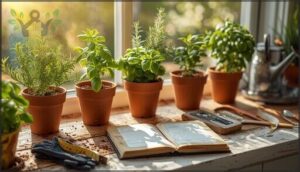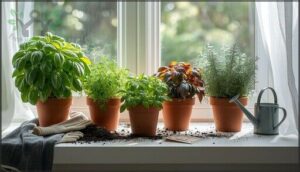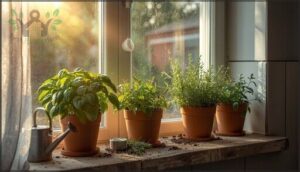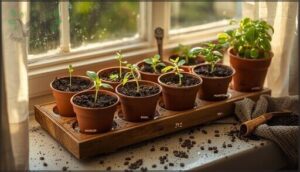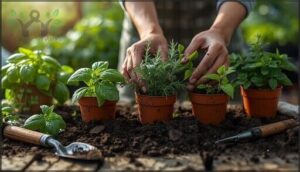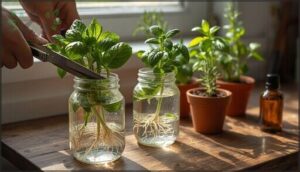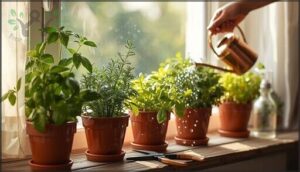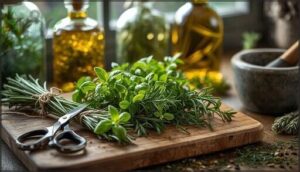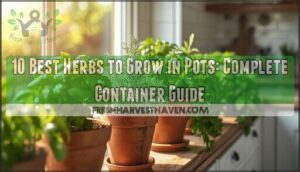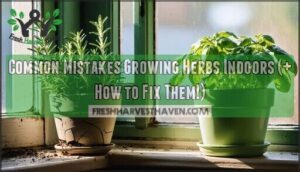This site is supported by our readers. We may earn a commission, at no cost to you, if you purchase through links.
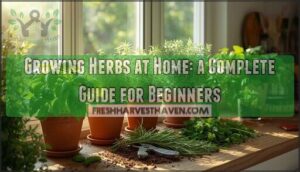
That potted basil you grabbed at the grocery store? It’ll probably be limp and brown within a week. Store-bought herbs come with a frustrating trade-off: pay premium prices for tiny packages that wilt fast, or settle for dried versions that taste like dusty memories of the real thing.
Growing herbs at home flips this script entirely. A single plant on your windowsill or patio can supply fresh leaves for months, transforming everyday meals with flavors no jar can match.
Beyond the culinary upgrade, you’ll gain a steady supply of natural remedies and aromatic greens without the markup or the waste. Whether you’re working with a sunny balcony or just a bright corner indoors, starting your own herb garden is simpler than you think—and the rewards show up in every dish you make.
Table Of Contents
Key Takeaways
- Growing herbs at home saves $100 to $600 yearly compared to buying fresh ones at the grocery store, with startup costs averaging just $25–$50 and easy varieties like basil yielding 500% return on investment.
- Most herbs need at least 6 hours of direct sunlight daily (or 12-16 hours under grow lights indoors), well-draining soil with pH between 6.0 and 7.5, and containers at least 8 to 10 inches in diameter with drainage holes.
- Regular pruning by removing stem tips triggers bushier growth and more productive plants, but you should never harvest more than one-third of the plant at once to keep it healthy.
- Harvest herbs in early morning when essential oils are most concentrated, then preserve them by air-drying in bunches, using a dehydrator at 95-115°F, or freezing in ice cube trays with olive oil for year-round flavor.
Why Grow Herbs at Home?
Growing herbs at home is more than just a hobby—it’s a simple way to improve your cooking, save money, and connect with a trend that’s taken root across the country.
Growing herbs at home improves your cooking, saves money, and connects you to a nationwide trend
You’ll discover that fresh herbs offer benefits you won’t find in the grocery store aisle, from richer flavors to real convenience.
Let’s look at three compelling reasons why starting your own herb garden makes sense.
Health and Culinary Benefits
Fresh herbs pack considerable nutritional value with concentrated antioxidant properties that help your body fight inflammation and support immune health. You’ll find vitamins A, C, and K in these flavorful plants, plus polyphenols that may reduce disease risk.
Beyond herbs for health, culinary herb uses shine in the kitchen—they boost flavor without extra salt or fat, making healthy eating genuinely enjoyable while boosting mental wellness through mindful cooking. Many also support heart health benefits.
Cost Savings and Convenience
Beyond the health perks, growing herbs at home delivers real grocery reduction—you can save $100 to $600 yearly compared to buying fresh culinary herbs. A small kitchen garden offers time efficiency too, eliminating extra store trips. Gardening can also lead to significant savings, as highlighted by National Gardening Association research.
Consider these benefits for beginner home gardener success:
- Startup costs average just $25–$50
- Easy-to-grow herbs like basil yield 500% ROI
- Waste reduction reaches 25–40% through harvest-as-needed
- Customization benefits let you choose rare varieties
- Immediate access beats any store run
Trends in Home Herb Gardening
Growing herbs at home isn’t just a passing fad. The global home gardening market is projected to hit $26.47 billion by 2034, fueled by pandemic influence and demographic shifts among younger generations. Millennials and Gen Z now dominate gardening stores, with 70% of 18-to-35-year-olds actively interested in small-space gardening.
Indoor herb gardens satisfy consumer preferences for sustainability impact while reducing packaging waste—a win for beginner home gardener budgets and the planet.
| Trend Driver | Key Impact |
|---|---|
| Market Growth | $15.78B in 2025, expanding 5.92% yearly |
| Younger Gardeners | 65% more Millennials, 40% Gen Z uptake |
| Sustainability Focus | 67% practice composting, water conservation |
Planning Your Home Herb Garden
Before you start planting, it helps to think about where and how your herbs will grow best. The right setup makes caring for them much easier.
Let’s look at the main options for planning your home herb garden.
Choosing Indoor Vs. Outdoor Spaces
Ever wondered how sunlight availability and space limitations shape your herb garden? Indoor herb gardens thrive with climate control and easier pest management, but yield expectations are lower due to limited sunlight requirements and root space.
Outdoor herb gardens offer bigger harvests, yet face weather swings and more pests. Container gardening bridges both worlds, letting you adapt to your home’s unique conditions.
Selecting a Garden Layout
When planning your herb garden layout, think about how much space you have and what fits your style. Quadrant gardens suit larger areas, while border designs work along fences for small-space gardening. Vertical systems let you grow up, not out, perfect for container gardening. Bed layouts offer easy access. Smart plant spacing and companion plants keep your garden design productive and beautiful.
Essential Tools and Materials
A solid herb garden starts with practical tools. You’ll want sturdy containers, potting mixes for good drainage, and a watering can with a gentle spout. Pruning shears help keep plants bushy, while grow lights bring sunlight indoors.
Don’t forget to check soil pH—herbs thrive at 6.5. Potting mix beats garden soil for container gardening, keeping roots healthy and strong.
Selecting The Best Herbs to Grow
Choosing which herbs to grow depends on your space, cooking style, and how much care you want to give. Some varieties are perfect for beginners, while others offer unique flavors or wellness benefits. Here’s what you should know before you pick your first seeds or plants.
Easy Herbs for Beginners
Did you know chives, basil, and mint are among the best herbs for beginners? These easy-to-grow favorites thrive in containers, offer distinct flavor profiles, and suit countless culinary uses.
When selecting herbs for beginners, avoid planting mint directly in garden beds—it’s invasive. Pairing chives with parsley or basil with thyme helps prevent beginner mistakes and creates tasty herb garden combinations.
Annual, Biennial, and Perennial Varieties
Choosing herb varieties means understanding their life cycle. Annual herbs like basil grow fast, often self-seeding for next year. Biennials, such as parsley, flower in their second season. Perennial herbs, including thyme and oregano, offer cold tolerance and long-term harvests.
Market trends show a shift toward perennial herbs, valued for consistent herb quality and easy care across seasons.
Herbs for Cooking and Wellness
You’ll want herbs that work double-duty in your kitchen and wellness routine. Basil, consumed by nearly 98% of people globally, offers culinary herb antioxidants and anti-inflammatory benefits. Parsley delivers cooking herb nutrients like vitamins C, A, and K.
These dual-use herbs support the herbal medicine growth trend—flavor profiles meet medicinal herb properties.
Consider pepper, rosemary, and thyme for their global herb consumption rates and proven herb health benefits during everyday culinary uses.
Setting Up The Perfect Growing Environment
Once you’ve chosen your herbs, it’s time to think about where and how they’ll grow best. The right setup doesn’t need to be complicated, but getting a few basics right makes all the difference between struggling plants and a thriving mini garden.
Let’s look at the key factors that’ll help your herbs flourish from day one.
Light Requirements for Herbs
Light intensity is crucial for a thriving herb garden. Most herbs require at least 6 hours of direct sunlight daily to develop their full flavor. If growing indoors, artificial lighting is a great alternative, with 12-16 hours under LED or fluorescent grow lights recommended.
Shade-tolerant herbs like mint can handle partial shade, while basil and rosemary thrive in full sun. Watch for signs of stress, such as leggy growth or leaf burn, and adjust the lighting accordingly.
Choosing Containers and Pots
Once you’ve sorted out lighting, it’s time to talk pots. Container gardening success starts with the right vessel. Look for containers at least 8 to 10 inches in diameter—size matters when roots need room to spread.
Drainage holes are non-negotiable; without them, your herb garden drowns. Material impacts watering frequency too: plastic holds moisture longer, while terra cotta dries faster, requiring more attention.
Ideal Soil and Drainage
Now that your container has proper drainage, the soil you put inside makes or breaks your herb garden. Most herbs thrive in well-draining soil with a pH between 6.0 and 7.5. A quality potting mix enriched with organic matter provides the nutrient balance herbs crave.
Here’s what matters:
- Use loam or sandy-loam soil types for ideal drainage methods
- Add 30-40% perlite to standard potting mix
- Test soil pH annually with an inexpensive kit
- Incorporate compost to boost organic matter content
- Avoid garden soil—it compacts in containers
Planting and Propagating Herbs
Once you’ve set up the right growing space, it’s time to get your herbs in the ground—or pot.
You have three main ways to start your herb garden, each with its own timeline and level of effort. Let’s look at your options so you can choose what works best for your schedule and budget.
Starting From Seeds
Growing herbs from seed is cost-effective and rewarding when you understand seed viability and germination rates. Start with easy herbs like basil, cilantro, or parsley.
Soil temperature matters—most herb seeds sprout best between 65°F and 75°F. Pay attention to sowing depth: plant small seeds about 1/4 inch deep, tiny seeds even shallower. Proper seed density prevents overcrowding.
With patience, you’ll see sprouts within 7–21 days.
Using Nursery Starts or Transplants
If you’d rather skip the wait, nursery starts offer a reliable shortcut. Transplanting seedlings brings you about 90% survival rates—far better than unpredictable germination.
Popular herb choices like basil, mint, and rosemary are widely stocked at garden centers, reflecting current consumer trends toward convenient, quick results.
Yes, they cost more upfront, but transplant establishment is simple. Just acclimate your herb plants outdoors for a week before planting.
Propagating From Cuttings
With a sharp pair of scissors and a healthy plant, propagating herbs from cuttings is surprisingly straightforward. Water propagation or soil propagation both work—your choice depends on the herb.
- Basil and mint root fastest in water, showing growth within 7–14 days
- Rosemary and thyme prefer soil propagation and take 3–6 weeks
- Cut 8–10 cm stems from non-flowering growth for best results
- Rooting hormones boost success rates by 15–30% for woody herbs
- Keep cuttings at 18–24°C with bright, indirect light
Stem propagation saves money and multiplies your favorite varieties effortlessly.
Caring for Your Herb Plants
Once your herbs are planted, they’ll need some ongoing attention to thrive. The good news is that caring for herbs doesn’t require a green thumb—just a few simple habits.
Let’s walk through the key practices that will keep your plants healthy and productive all season long.
Watering and Fertilizing Techniques
Think of watering as reading your plants’ signals. Check soil moisture by feeling the top inch—water when it’s dry to the touch. Most herbs need watering once or twice weekly, though potted plants dry faster.
For fertilizing, organic options like compost feed your herbs gradually without harsh buildup. Apply balanced fertilizer every four to six weeks, and watch for yellowing leaves signaling nutrient deficiencies.
Pruning for Bushy Growth
Regular pruning transforms spindly herbs into lush, productive plants. Use heading cuts to remove stem tips, triggering side shoots for bushier growth. Tipping methods—snipping 1 to 2 inches above a leaf node—split growth points into multiple branches.
Pinching flowers redirects energy to foliage instead of seeds. Make diagonal cuts with sharp tools for faster healing.
Never remove more than one-third at once, and you’ll keep encouraging fresh new growth all season.
Preventing Pests and Diseases
Preventing herb pests starts with early detection—check leaves weekly for aphids, spider mites, or fungus gnats.
IPM strategies combine organic solutions like neem oil with companion planting using marigolds or garlic to deter invaders.
Good spacing improves airflow for disease control, while removing debris cuts pest hideouts. Avoid overhead watering and excess nitrogen to strengthen disease resistance naturally.
Overwintering Perennial Herbs
Overwintering herb plants takes smart planning before frost hits. Cold-hardy perennial herbs like sage and thyme survive to -10°F, but root protection matters most.
Here’s your dormancy preparation checklist:
- Stop harvesting 4–6 weeks before frost to reduce plant stress
- Apply 2–3 inches of mulch after first frost for cold tolerance
- Move tender perennials like rosemary indoors with indoor acclimation over seven days
- Water sparingly to prevent root rot during winter care
Harvesting and Preserving Your Herbs
You’ve put in the work to grow your herbs, and now it’s time to enjoy the harvest. Knowing when to snip those leaves and how to preserve them will keep your kitchen stocked with flavor all year long.
Let’s walk through the simple techniques that’ll help you get the most out of every plant.
When and How to Harvest for Flavor
Harvesting herbs at the right moment makes all the difference in flavor. Cut in the early morning after dew dries but before the day heats up. That’s when essential oils are most concentrated.
Use clean, sharp scissors and harvest no more than one-third of the plant. Timing and technique protect flavor and keep your herbs producing all season long.
Drying and Freezing Methods
Once you’ve harvested your herbs, preserving them is simple. Drying and freezing are two reliable methods that lock in flavor and extend shelf life.
Choose your preservation method wisely:
- Hang small bunches in a shaded, airy spot until leaves crumble easily—usually one to two weeks
- Use a dehydrator at 95-115°F for faster, controlled drying with better color retention
- Freeze herbs in ice cube trays with olive oil for easy cooking portions
- Remember frozen herbs work best in cooked dishes, while dried herbs pack concentrated flavor
Storing Herbs for Long-Term Use
After drying or freezing herbs, proper storage makes all the difference. Keep dried herbs in airtight glass jars—Mason jars work perfectly—stored in a dark cabinet away from heat and light. These ideal conditions preserve quality and extend shelf life up to three years.
Different container types matter less than the seal itself. Good herb storage means you’ll save money while enjoying homegrown flavor year-round.
Frequently Asked Questions (FAQs)
Can you grow herbs at home?
Yes, you can grow herbs at home with ease. Picture snipping fresh basil from your kitchen windowsill—90% of gardeners find herbs easier to grow than vegetables, making them perfect for beginners.
Can you grow herbs indoors?
Growing herbs indoors works beautifully with the right setup. Position your windowsill garden near a sunny window or use LED grow lights.
Monitor temperature control and humidity management for indoor herb success, especially when propagating.
How do you start an indoor herb garden?
Choose containers with drainage holes and fill them with quality potting mix.
Place your windowsill garden near a sunny window or use LED grow lights.
Maintain proper temperature control and humidity for thriving herbs.
Can I grow herbs without any sunlight?
Not quite—most herbs need some light to survive. However, low-light herbs like mint and parsley can thrive indoors with LED grow lights, making indoor herb garden setup possible even in windowsill garden spaces with limited natural brightness.
How do I revive a dying herb plant?
First, diagnose the problem—check for yellow leaves, root rot, or pests.
Address watering issues, adjust light exposure, refresh soil practices, prune dead growth, and control pests to restore plant health effectively.
Which herbs grow well together in containers?
Think of your container as a neighborhood—basil, oregano, and parsley thrive together with similar water needs, while rosemary, thyme, and sage prefer drier soil.
Companion planting maximizes space and naturally aids pest management.
Do herbs attract beneficial insects to my garden?
Yes, herbs attract beneficial insects. Flowers from basil, dill, fennel, and oregano draw pollinators like bees and predatory insects like ladybugs, enhancing pest control and insect biodiversity while improving your herb garden’s health naturally.
Can I use tap water for watering herbs?
You can use tap water for watering herbs, but letting it stand 24 hours helps chlorine evaporate.
Watch for mineral buildup and consider filtered water if your herbs show yellowing or stunted growth.
Conclusion
Picture yourself months from now, pinching fresh oregano for a weeknight pasta or snipping mint for your morning tea—no grocery run required. Growing herbs at home transforms that vision into daily reality.
You’ve got the blueprint: the right plants, proper care routines, and harvesting methods that keep flavors at their peak. Start with one or two favorites today. Your kitchen will thank you, and those wilted grocery store bundles will become a distant memory.
- https://extension.wvu.edu/lawn-gardening-pests/gardening/gardening-101/herb-gardening-for-beginners
- https://cmg.extension.colostate.edu/Gardennotes/731.pdf
- https://www.flipkart.com/jetfire-gardening-set-5-scissor-prune-gloves-wooden-garden-tool-kit/p/itmfd8fd4341a538?pid=GTSGAB6YFKUTPJRZ&lid=LSTGTSGAB6YFKUTPJRZUINHFC&marketplace=FLIPKART&q=jetfire+garden+tool&store=h1m%2Fum7%2Fyse%2Fixk&spotlightTagId=default_TrendingId_h1m%2Fum7%2Fyse%2Fixk&srno=s_1_1&otracker=AS_Query_HistoryAutoSuggest_1_7_na_na_na&otracker1=AS_Query_HistoryAutoSuggest_1_7_na_na_na&fm=search-autosuggest&iid=cf3d195b-5c01-4aab-af2d-82f592d9a5d2.GTSGAB6YFKUTPJRZ.SEARCH&ppt=sp&ppn=sp&ssid=u7gwy2gkps0000001759903258215&qH=7dba325f79d9eb5a
- https://www.facebook.com/groups/simplesavers/posts/2602930933189827/
- https://luckboxmagazine.com/trends/thyme-is-money/

